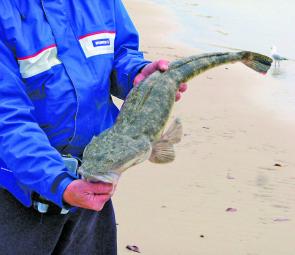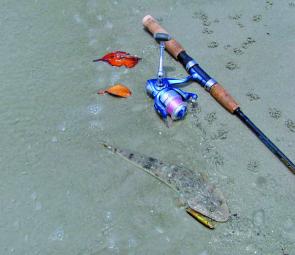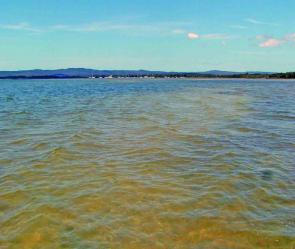One of the most enjoyable forms of fishing, and one of my favourites, is walking the sand and mud flats surrounding my home in Tin Can Bay. It’s a most pleasurable form of fishing and for those not fortunate enough to have their own boat this can still be a very productive way to fish, if you approach it in the correct way.
In this article I will attempt to show you how, where and what tackle you will need to ‘walk the flats’.
The bonus of this type of fishing is you don’t need to spend a fortune on tackle to equip yourself. My outfit consists of a Shimano Sonic Pro rod 702SP 2-4kg line weight, it’s a touch over 2m long and extremely light and strong. I have fitted a Pflueger Asaro reel, a great little reel well equipped to handle most things that you will encounter, and it is spooled with 4kg Platypus low stretch and a leader of Berkley Vanish fluorocarbon of about 7kg.
The only other items you will need is a shoulder bag, small landing net, long nose pliers and a knife and a water bottle for good measure. A waist belt with pockets is also good to store your lures, spare leader material and scissors, and a small plastic lure box that holds about 10 lures.
If you were to buy all of the above new it would cost you about $250. Nevertheless, most of us already have some of the items and you can usually get the rod and reel for a reasonable price.
The enormous selection of lures to choose from can often be confusing. Just remember you won’t need to carry many, it’s more important to have a selection to choose from. I would normally carry two to three shallow divers, the same number of small poppers and stickbaits, and a couple of small blades for good measure. Ten lures should cover a lot of different situations that you may encounter on your wonderings.
The lures I prefer are Berkley Frenzy 60mm shallow diver, Jazz Lures Zappa 55 in the clear finish and pale ale, River2Sea Bubble Pops in a clear or pearl finish, and throw in a couple of Jazz Lures Rock Fish Blades and you’re pretty much ready to go. Most of these are around $10.
You may have your own favourites or plastics so take whatever you have confidence in. You are going to spend a couple of hours walking combined with endless casting so you really need to have confidence in your selection.
Regardless of where you are in Australia, most sand flats have similar features and will fish the same – as long as you know what you’re looking for.
Before you head off, have a look at where you are going to fish at high tide and at low tide. Look for those areas that will hold the fish; reading a sand flat is like reading a beach you will soon learn the basics. A drain empting the flats into a shallow bay, an isolated rock or mangrove tree, sand ridges that form gutters and creeks that dissect the flats, all have to be investigated. As the tide changes so will these areas as they all have different characteristics at different times of the tide.
With out a doubt in my mind the best time is the last hour of the run-out and the first hour or so of the run-in, and if this coincides with early morning or late afternoon it’s even better, my favourite is late afternoon.
The bigger tides seem to be better as the flats generally drain well, you will find with the smaller tides that some of the flats will still hold varying depths of water thus not forcing the bait into the deeper sections. This will keep your target fish spread out and makes your job that little bit harder.
As the flats drain the small baitfish and prawns will look for shelter in the tidal zones that still hold water until the tide changes. It’s here the predators will also concentrate and if there’s a good yabby bank all the better.
These low tide ‘basins’ are your first areas to fish. My usual routine is to quietly, and I mean quietly, walk out into the water for 20m or so and survey the scene. Look for bait flicking, a flash in the water that might indicate a feeding school of whiting, etc. A good pair of Polarized glasses are invaluable when negotiating the flats, not only for spotting fish but to help you sight other creatures you may not want to walk on!
Start systematically working the area starting at 9 o’clock and working around to 3 o’clock until you locate that first fish. They could be working along the edges where the bait is lying, they could be lying in front of the drains waiting for small bait to be flushed out or they could be in deeper water waiting for the change.
Once you locate the first fish concentrate on that area and work it for 10 minutes, as you will often pull more than one flathead out of an area. If the bite goes quiet move 10m and repeat the process. I generally pick my route depending on the bottom; I like changes in colour from sand to mud and maybe a little weed. A sand bank that is slightly shallower than the surrounding water is an ambush site for most predatory fish.
If your path takes you through a muddy section it often pays to put in a few casts back along where you have just walked. The stirred bottom can often attract whiting, stingray, there really is no shortage up here!
Water depth is important, water up to my knees or slightly higher is the maximum you need, don’t be surprised if you find big lizards in ankle deep water! Only recently I was fishing in a basin when a young couple walked out to the deeper water looking for a monster fish. In the two hours I was there I caught and released 11 flathead up to 45cm but they didn’t get a fish. They actually walked past where the fish were laying!
As the tide changes concentrate your casts to seaward as the flathead, in particular, will be laying into the current. A natural presentation will get results. As the tide starts to cover the flats the flathead, bream and whiting will also move in using the deeper gutters and to ambush the bait that are travelling the same route. It’s now that you move casting over the sand ridges into the deeper sections working your way up into the shallow water. Standing on the ridges and casting along the edges is another option; I usually like to keep the water at about calf to knee height.
As the tide floods the flats, it’s pays to move again. Once the flats are covered, even partially, it’s time to change tactics. That isolated tree or rock previously noted now comes into play, walking the tide in can produce the odd fish and it’s more than likely it’s around these isolated structures. A lure change would also be required swapping the shallow diver and opting for a stickbait or popper.
Now that the tide is full you are probably back in close along the shore line and thinking of going home. Wait, not all is lost, before I head off home I always put a few casts in amongst the mangroves and rock bars, you just never know. Casting in among the mangrove roots with the Zappa or Bubble Pop may attract the attention of a bream or whiting as they forage amongst the root system, particularly in fading light.
When using your lures vary your technique, a little wrist action on the shallow divers gives them a jerky action and the flathead in particular can’t resist them. With the stickbaits and poppers a similar action can be used, if you think it’s bream striking at the lure it often pays to stop your retrieve and they will continue to hit it until hooked.
Fishing in and around Tin Can Bay can produce some pretty exciting flats fishing. All the normal species are encountered: flathead, whiting and bream. There’s always the chance of a golden trevally, and the marauding alligator gar will add that little extra bit of excitement. If you do manage to hook one of these toothy pick-handles watch your fingers and toes!
There is always one factor in all facets of fishing that makes it a good day or a bad day and that’s the weather. It can, and does, stop a lot of boaties fishing at times. Yet, on the sand flats it can be beneficial.
Wind is generally a pain in the backside but in fishing the flats it becomes an advantage. Friend, and fellow flats wanderer, Paul Tedman and I have fished in 20 knot wind and the results have been impressive. Paul even managed five different species in one outing by making use of the wind.
By standing with the wind at your back you can achieve extremely long casts with the light tackle. You might not be able to fish some areas but you make it up with these long casts and the fish don’t care about the ruffled water.
Those clear windless days that we all dream of are great for some things but the advantage is firmly back with the fish; they will see you long before you make contact with them. Stealth and patience is required, it’s these days that the Zappa and Bubble Pops come into their own, those little clear plastic lures zigzagging across the surface are irresistible to most whiting and bream. And when you experience your first surface strike by a flathead you wont want to go home, it’s a spectacular sight when they launch themselves clear of the water.
If you can fluke a day with overcast conditions 10 knot winds, low tide in the late afternoon and falling either side of a full or new moon, don’t sit around! Get your shoulder bag and go for a walk, the results will surprise you.
Wandering the flats is a challenging form of fishing which on some days can provide limitless fun and a feed. It can however have its slow times but that’s the law of averages, you can’t have it good all the time but it sure is fun trying. Have a go you will be surprised.
Reads: 8114
A typical sandy strait’s shallow water lizard falling yet again to the Berkley Frenzy.

A small flathead coudn’t resist the Zappa walked across a shallow gutter.

The sand ridges can be clearly defined flanked by deeper water. It’s prime ambush country, work along the ridge and cast to either side, and don’t forget to cast along the edges as you go. Even at low tide the water in between these ridges is deep en

The lures: Berkley Frenzy (top left), Zappa 55 (top right) and Bubble Pops (bottom right). There are plenty more to choose from but these little lures have proven themselves time after time for me.




